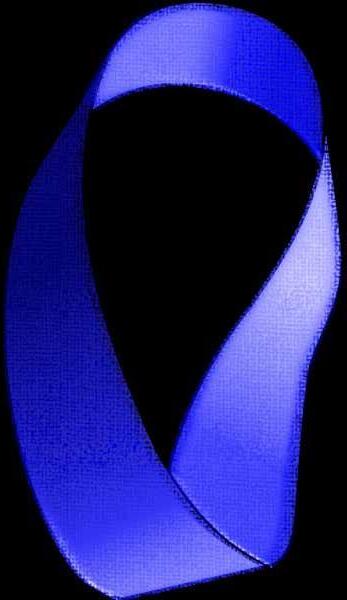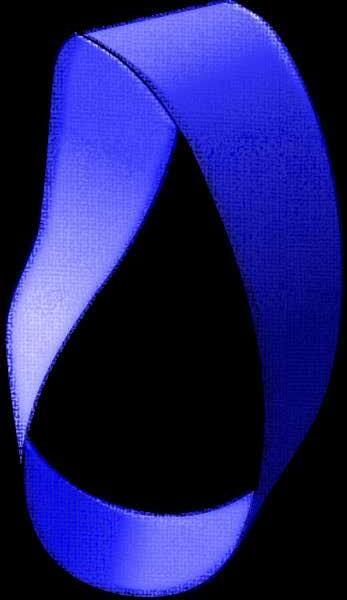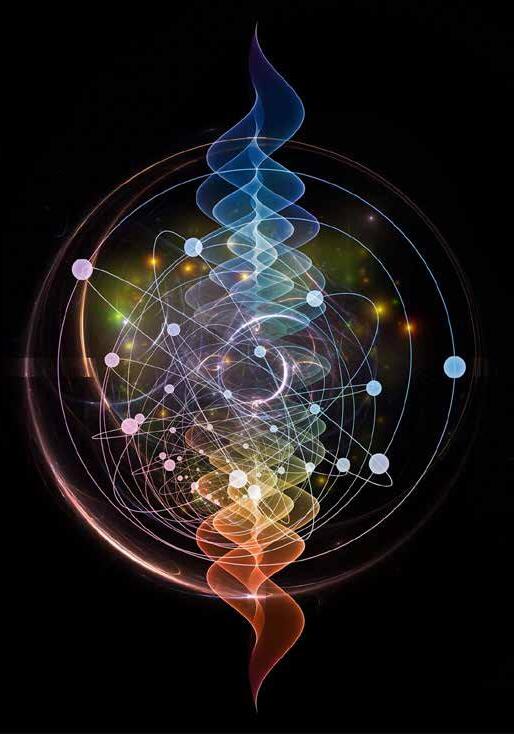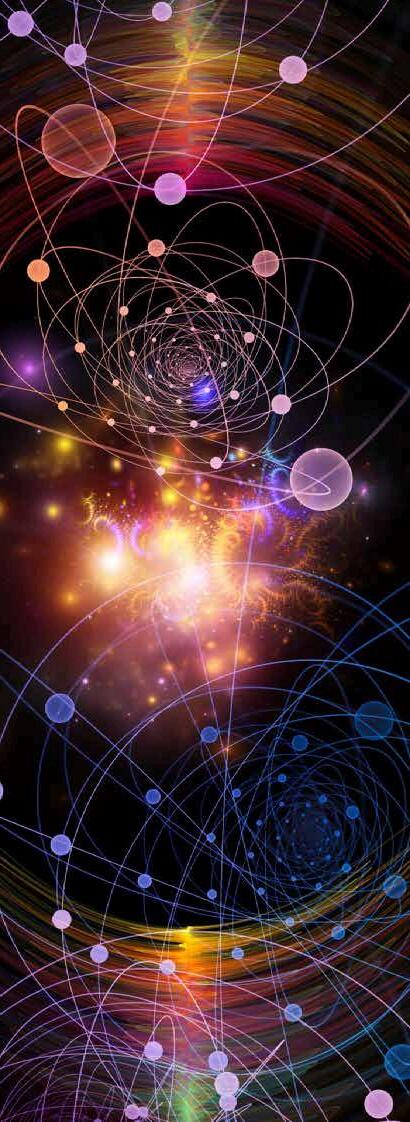
6 minute read
The Mobius Strip
from DC QUANTUM
by MahaNawaz
The mathematics
The Möbius band is a manifold1 named after August Ferdinand Möbius (1790-1868), who was a German mathematician and theoretical astronomer who was the second to discover it in September 1858, also named the twisted cylinder and the Moebius strip. Another German mathematician Johann Benedict Listing started the study of surfaces, which he named topology2, and concluded the properties of the Möbius strip in July 1858 before him, published in 1862.
Advertisement
At first glance, the “optical illusion” might seem simple to us, but is a mystery which has baffled scientists, artists and mathematicians alike for centuries.
It is a one-sided and one-edged strip of material with length, width and depth/height, which can be made by twisting an odd number of times a two-sided and two-edged rectangle 180° and merging the two ends, and simultaneously the inner and outer surfaces, together, creating a curved surface. It is one of the examples of a 2D plane existing in a 3D space, and even when cut in parts with a line down the middle, the shape remains the same.
The Möbius strip is not oriental3. It is made from a surface mathematicians call “developable” and a surface with a boundary compared to a true surface, which means it can be flattened without changing its unaltered shape.


It is known that after the strip is made, it will try to return to a state in which it contains the minimum amount of elastic energy possible, much like an elastic band.
The Thoughts
A map on a sphere or plane only needs four colours to be coloured so no bordering countries are the same colour, hence dubbed the four-colour theorem. However, a Möbius strip requires six colours for this rule to function, adequately named the six-colour theorem.
The strip is critical in future work. Many scientists have tried to solve for a dimensional equation of this strip using unpublished calculations, and some believe it would be based on the length and width of the starting rectangle; however, there is much speculation regarding this.
The theory of the Möbius strip goes beyond the strip itself, applying to many objects in many ways.
This calculation might be critical for future technological developments, such as the description of graphene sheets when wrapped into carbon nanotubes, the shapes of leaves and chemical film, or understanding crumpling.
The Art
A real Möbius strip rarely occurs in nature (and where it does, it is unclear and cannot be manufactured).
It is often called an “impossible shape”, although similar models can be made where we live.
The immergence of the Möbius strip in art happened entirely independent of mathematics Swiss artist Max Bill probably thought he had invented a new geometrical shape upon sculpting “Endless Ribbon” in 1936, which he said was designed to look like "flames rising from a fire".

Musicians’, writers’, and artists’ perception of the world have been transformed, creating an immerging culture of its own, with Möbius-themed music, art, architecture (e.g. rollercoasters) and merchandise (e.g. jewellry, conveyor belts, recording tapes, printer ribbons, computer print cartridges) included.
The Möbius strip is a door to possibility, and also a door to the end.
The Möbius strip can remain a fun experiment and an impossible mystery. In philosophy, it serves as a reminder that no matter how far you travel and what path you choose, you will always end up where you started, sometimes in an unrecognisable way. But in this world, like all worlds, up is down, right is left, in is out and we are all just one part of the same messedup universe.
1A space locally resembling a Euclidean space2 near points 9
2A 2D or 3D space representing physical space which follows the laws of Euclidean geometry3
3the study of geometric surfaces and planes assuming axioms and theorems are true
2the study in which objects are assumed to be equivalent if they can be altered to change into the other
3(For a 2D object in a 3D space): the ability to name directions on an object that won’t change after alterations of movement
Moebius Strip
II – Woodcut by Maurits Cornelis Escher, 1964
“Endless Ribbon” – band
If you imagine the arrows are connected, the recycling arrows form a Möbius strip

Mobius Arch - Image in the public domain in the United States
References:
1. Google Books. (2013). The Handy Math Answer Book. [online] Available at: https://books.google.ae/books?id=sgRlCwAAQBAJ&pg=PA211&lpg =PA211&dq=Did+M%C3%B6bius+publish+his+findings?&source=bl &ots=hMNtLkHyXi&sig=ACfU3U1oBpFIxYXz1uGpKVfq5lk0ybRt5Q& hl=en&sa=X&ved=2ahUKEwi59sf41tr3AhWxzIUKHVt8CU4Q6AF6BA gtEAM#v=onepage&q=Did%20M%C3%B6bius%20publish%20his%2 0findings%3F&f=false [Accessed 24 Jun. 2022].
2. Nebus, J. (2020). My All 2020 Mathematics A to Z: Möbius Strip. [online] nebusresearch. Available at: https://nebusresearch.wordpress.com/2020/09/09/my-all-2020mathematics-a-to-z-mbius-strip/ [Accessed 24 Jun. 2022].
3. Wonderopolis.org. (2018). What Is a Möbius Strip? [online] Available at: https://wonderopolis.org/wonder/What-Is-aM%C3%B6bius Strip [Accessed 24 Jun. 2022].
4. COMSOL. (2019). Möbius Strips: Where Math Meets Art. [online] Available at: https://www.comsol.com/blogs/mobiusstrips-where-math-meets-art/ [Accessed 24 Jun. 2022].
” Mobius Strip shimmers at night” – Photo by Steve Krave, TD: “What light through a single surface breaks”

The Quantum Border: Where do the worlds of Quantum and Classical Physics Meet?

The quantum realm exists. It has been proven by numerous experiments conducted by physicists over time. But if that’s true, why don’t we see it all the time? Why can’t we find ourselves in many places at once? If everything on a micro scale is intrinsically uncertain, why does our world seemingly follow the rigid rules of classical physics?
First, let’s delve into the basics of quantum physics. Imagine you have an orange and two crates: Crate A and Crate B. According to our classical understanding, a single orange can only be in one of the crates at once. However, if the orange was a particle like a photon, quantum rules dictate that it actually exists in both crates at once, in a superposition of Crates A and B and many other possibilities. It is represented by equations called wave functions, with the amplitude at each peak being the probability of the orange being at that position.
That’s all very well but we never see an orange in more than one place. Even on a micro scale, when a particle is measured by a scientist, all of its quantum possibilities seem to be reduced to one certain event, like the orange being found in Crate B in an experiment. It leaves the state of being in a superposition and is forced into the ‘normal’ realm. How does the minuscule world of quantum possibility make the jarring transition into the quotidian realm? The honest answer is we don’t know – yet.
There are many theories.
In the 1920s, Werner Heisenberg gave rise to the idea that the act of a person measuring the position of the particle would cause the superposition to collapse and the particle to select a definite position to be in. Unfortunately, no components of wave equations actually indicate that a collapse occurs. While some people have accepted the idea, many physicists remain sceptical. If quantum physics is the foundation for the whole universe, how could humans have an influential role in its outcomes? While it may have some flaws, the Collapse at Measurement Theory has led to the generation of other theories, including the idea of random, spontaneous collapses in the Ghirardi-Rimini-Weber model and collapses caused by gravity in the Diósi-Penrose Model.
Another idea, known as decoherence theory, suggests that the particle never leaves the state of being in superposition. The particle only appears to be fixed and certain to us because, in the real world, the wave functions are entangled with the environment in such a complex mesh of probability that, when we take a measurement, we can only perceive one strand of the intricate web. This strand is what we believe to be the ‘real’ position of the particle. However, if decoherence theory is true, why aren’t we ever able to see more than one part of the web of wave functions?
One of the wildest theories is the ‘many worlds’ interpretation, argued by Hugh Everett in 1957. It goes hand-in-hand with the concept of the multiverse. Yes, the multiverse is actually something in physics - I haven’t just been watching too many marvel movies. It’s a theory in Cosmology that considers whether our universe is singular or if it is only one of many universes that make up the multiverse. It suggests that there was a stage, early in the development of the cosmos, when it expanded at an exponential rate. During this period of cosmic inflation, parts of the cosmos ended their expansion at different times to other regions, forming bubble universes. In other words, if the multiverse is a bowl full of soapy water, our universe is one of the bubbles.
How does Everett’s theory link to the multiverse? He believed that the particle stays in a state of superposition and is instead determined by the universes. The idea is that, for every time you find the orange in Crate B, the orange is found in Crate A in another universe so it’s never truly in a certain place. Every measurement branches off with different outcomes in different universes. There are many theories that seek to explain the dilemma of the border between quantum and classical physics, each one fascinating in its own way. However, the truth of the overlap remains a mystery. While this article tries to simplify the ideas, the actual nature of the quantum realm has many parts, related by complex formulae. Perhaps, in the future, we may be able to find a definitive answer. Who knows? You could be the next physicist to provide a theory.

References:
1. Ghirardi, G. C.; Rimini, A.; Weber, T. (1986). "Unified dynamics for microscopic and macroscopic systems"
2. Diósi, L. (1989). "Models for universal reduction of macroscopic quantum fluctuations"
3. Penrose, Roger (1996). "On Gravity's role in Quantum State Reduction".








